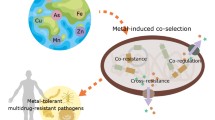Abstract
IN many bacteria, resistance to heavy metals is associated with a plasmid1–4. R plasmids in Escherichia coli can determine resistance to several metallic ions such as mercury, cobalt and nickel3, and a penicillinase plasmid mediating resistance to mercury, cadmium, arsenate, arsenite, lead and zinc has been observed in Staphylococcus aureus1,2. Mechanisms controlling bacterial resistances to mercury and cadmium are quite different although both are mediated by the same penicillinase plasmid4. Furthermore, microorganisms generally detoxify mercurial compounds metabolically by the formation of volatile mercury5–9 or mercury mercaptides10–12. It is of interest that resistance to these heavy metals is mediated by the plasmids which determine resistance to antibiotics. Most of these heavy metals are established or possible causes of environmental pollution; methyl mercury causes ‘Minamata disease’13,14 and cadmium causes ‘Itai-Itai disease’15,16 in Japan. The role of R plasmids in drug resistance has been widely studied17–21, and extrachromosomal determinants are a main cause of the increase in numbers of drug-resistant bacteria. Studies of heavy metal resistance have attempted to establish a relationship between resistance to heavy metals and to drugs in the hospital environment22,23. The factors selecting for these heavy-metal-resistant bacteria have not yet been identified. We believe that heavy-metal-resistant microorganisms do not arise by chance, but, that there must be selectional factors beyond mere drug resistance. One of these selectional factors may be environmental contamination by heavy metals. To investigate this possibility, we studied the frequency of drug and heavy-metal resistance in clinical isolates of E. coli, Klebsiella pneumoniae, Pseudomonas aeruginosa and S. aureus. We report here that the frequency of heavy-metal resistance in these strains was the same as, or higher than that of antibiotic resistance. Some R plasmids in E. coli and K. pneumoniae also carried a resistance to Hg.
Similar content being viewed by others
References
Richmond, M. H. & John, M. Nature 202 1360–1361 (1964).
Novick, R. P. & Roth, C. J. Bacteriol. 95, 1335–1342 (1968).
Smith, D. H. Science 156, 1114–1116 (1967).
Kondo, I., Ishikawa, T. & Nakahara, H. J. Bacteriol. 117, 1–7 (1974).
Tonomura, K., Maeda, K., Futai, F., Nakagami, T. & Yamada, M. Nature 217, 644–646 (1968).
Ben-Bassat, D., Shelef, G., Gruner, N. & Shuval, H. Nature 240, 32–44 (1972).
Summers, A. O. & Silver, S. J. Bacteriol. 112, 1228–1236 (1972).
Nelson, J. D., Jr, Blair, W., Brinckman, F. E., Colwell, R. R. & Iverson, W. P. Appl. Microbiol. 26, 321–326 (1973).
Schottel, J., Mandal, A., Clark, D., Silver, S. & Hedges, R. W. Nature 251, 335–337 (1974).
Wood, J. M., Kennedy, F. S. & Rosen, C. G. Nature 220, 173–174 (1968).
Wood, J. M. Science 183, 1049–1052 (1974).
Hamdy, M. K. & Noyes, O. R. Appl. Microbiol. 30, 424–432 (1975).
Hirayama, K. & Takahashi, H. Kumamoto Med. J. 23, 56–64 (1970).
Takizawa, Y., Kosaka, T., & Sugai, R. Acta Med. Biol. (Niigata) 19, 193–206 (1972).
Tsuchiya, K. Keio. J. Med. 18, 181–194 (1969).
Emmerson, B. T. Ann. Intern. Med. 73, 854–855 (1970).
Watanabe, T. Bacteriol. Rev. 27, 87–115 (1963).
Curtiss, R., III Ann. Rev. Microbiol. 23, 69–136 (1969).
Datta, N., & Hedges, R. W. Nature 234, 222–223 (1971).
Mitsuhashi, S. in Transferable Drug Resistance Factor R (ed. Mitsuhashi, S.) 7–16 (University of Tokyo Press, Tokyo, 1971).
Lacey, R. W. & Richmond, M. H. Ann. N. Y. Acad. Sci. 236, 395–412 (1974).
Moore, B. Lancet ii, 453–458 (1960).
Dyke, K. G., Parker, M. T., & Richmond, M. H. J. med. Microbiol. 3, 125–139 (1970).
Author information
Authors and Affiliations
Additional information
(to whom reprint requests should be sent).
Rights and permissions
About this article
Cite this article
NAKAHARA, H., ISHIKAWA, T., SARAI, Y. et al. Frequency of heavy-metal resistance in bacteria from inpatients in Japan. Nature 266, 165–167 (1977). https://doi.org/10.1038/266165a0
Received:
Accepted:
Issue Date:
DOI: https://doi.org/10.1038/266165a0
- Springer Nature Limited
This article is cited by
-
Diversity, community structure, and bioremediation potential of mercury-resistant marine bacteria of estuarine and coastal environments of Odisha, India
Environmental Science and Pollution Research (2016)
-
Characterization of a marine-isolated mercury-resistant Pseudomonas putida strain SP1 and its potential application in marine mercury reduction
Applied Microbiology and Biotechnology (2012)
-
“Trade-off” in Antarctic bacteria: limnetic psychrotrophs concede multiple enzyme expressions for multiple metal resistance
BioMetals (2007)
-
Metal and antibiotic-resistance in psychrotrophic bacteria from Antarctic Marine waters
Ecotoxicology (2006)
-
Inorganic-ion resistance by bacteria isolated from a Mexico City freeway
Antonie van Leeuwenhoek (1995)





